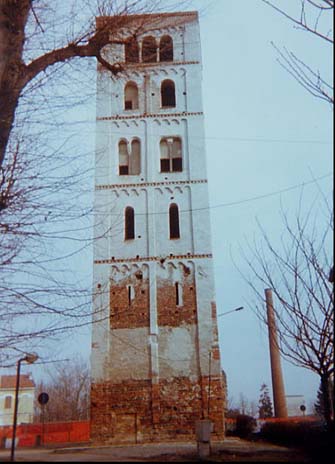 |
St. STEPHEN’ S BELFRY |
| On the eastern side of the public garden there is St.Stephen’s tower, the only part still existing of the Benedictine church and monastery. It was built in the XI century, when Enrico II, Ivrea’s bishop, made St.Stephen’s structure bigger, to receive the Benedictines. The belfry is the most important example of Eporedian Romanic art. | |
Over the base floor partially buried with loop-holes on the east and north side, there are three floors of about four metres the first with other loop-holes on the east north and west side, the second with two-mullioned windows and the third with three-mullioned windows on all the four sides. The architectural decoration is composed by angular pillars and an intermediate thinner one. The fifth floor shows a sudden reduction in height , from four metres to three metres and thirty, there is no more central pilaster, a lower three-mullioned window appears and the small hanging arches come lower down on the windows. This fall in style is more evident on the sixth and last floor, that has a height of two metres and seventy, with one more three-mullioned window, on which the little arches have no more space and are crushed. All this makes us think of an over-elevation, in fact it’s very probable that in its original form it should have kept the constant height of the storeys and progressively increased the size of the windows, but in 1117 it was destroyed by the violent earthquake that affected the Diocese of Ivrea. |
 |
Other damage was suffered by the belfry in the siege in 1704 with, on the French side, a massive use of artillery. The walls and small arches were rebuilt in bricks but the windows were not replaced and only covered up. Archives documents show that there was little care taken of the belfry. Having no more parish functions, and having no income, it didn’t get the cares of the administrator. In 1827 the tower’s ground-floor was used as a stable. In 1854 a brick vault, plastered with asphalt, was built on the top floor of the belfry, to replace the spire that had been destroyed. In 1880 the municipality used the belfry as a tower for the water main’s distribution. |
|